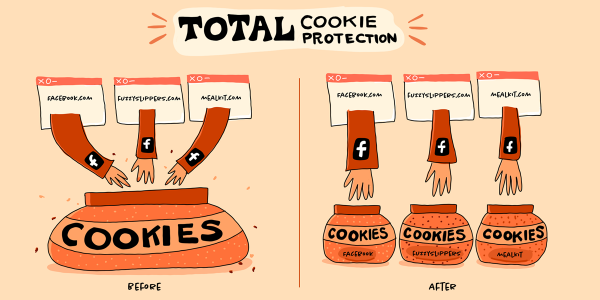Conversion Modelling refers to the use of machine learning to quantify the impact of marketing efforts when a subset of conversions can’t be observed.
This will become extremely important when measuring conversions across devices in a world without cookies that are available to link these devices. Without it, you’ll be unable to attribute some of your conversions to the corresponding customers who interacted with an ad.
With companies like Apple and Firefox restricting third-party cookies, attribution has become difficult when customers are using these devices and browsers.
Total Cookie Protection (Illustration: Meghan Newell)
If no modeling techniques are employed, this attribution problem will leave holes in the customer journey, prohibiting you from fully understanding your customers’ paths to conversion. But with a Conversion Modelling foundation in place, observable data can feed algorithms that also make use of historical trends to confidently validate and inform measurement.
Accurate measurement of anonymous data
Modelling enables accurate measurement while only reporting on aggregated and anonymised data. This unlocks results in a privacy-centric picture of your customer behavior, ensuring that your performance doesn’t suffer just because the direct measurement isn’t always possible.
Moving forward, measurement via third-party cookies will become increasingly difficult as in 2022, it is estimated that 88% of browsers in APAC will restrict the collection of third-party cookies.
An essential piece to the puzzle
Without Conversion Modelling in place, it’s not just the measurement framework for one campaign that’s affected. There’s an impact on the overall health of your business. If conversions can no longer be measured, measurement solutions wouldn’t work properly, meaning Google’s automation and optimisation solutions wouldn’t work properly which would result in reduced revenue.
If modelling is built into the structure of your measurement solutions, it can provide an essential safeguard that automatically fills gaps using data-driven signals customised to your campaigns. Accurate measurement is the essential foundation upon which your optimisation and data-driven business decisions are built on.
Filling in the gaps
With the recent trend in increased user privacy, not being able to collect information via third-party cookies is leaving gaps in the customer journey – making it difficult to attribute, measure and optimise digital marketing efforts.
Creating a reliable, accurate, aggregated view of customer behavior, machine learning analyses current observable signals, such as device, date and time, conversion type, and model across campaigns.
Having access to these measurement capabilities, powered by an extensive data set, removes uncertainty and ensures that reporting automatically benefits from modelling.
This level of automation is especially important as measurement expectations change rapidly, you must be ready to adapt to quick changes to conversion observability.
The importance of tagging for Conversion Modelling
Having a strong online infrastructure is important for creating a data-driven environment for modelling and mitigating further conversion loss.
The key to achieving this is to implement solutions that can help increase the amount of observable data for your campaigns. The importance of tagging for trustworthy conversion measurement is undeniable, and essential for any form of capable conversion tracking.
By proactively taking advantage of tools like Google Tag Manager or global site tag on your website, you can ensure that your infrastructure is set up for measurement success on Google Ads and Google Marketing Platform.
